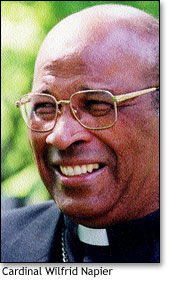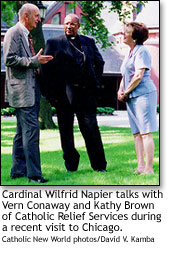 |
 |
|||||
 |
 |
 |
 |
| AIDS in Africa South African cardinal preaches help, hope By Michelle Martin Staff writer  When Cardinal Wilfrid Napier of Durban, South Africa, joined other clergy members in visiting a young mother with AIDS, the first thing he felt was her suspicion. When Cardinal Wilfrid Napier of Durban, South Africa, joined other clergy members in visiting a young mother with AIDS, the first thing he felt was her suspicion.“I could feel her sense of apprehension,” said Cardinal Napier, on a visit to Chicago with representatives of Catholic Relief Services. “I felt that she was asking herself, ‘What are they going to do, condemn me?’” The only thing that set the young woman at ease was the presence of the outreach nurse who regularly visited the patient, said Cardinal Napier, president of the Southern African Catholic Bishops Conference. The conference includes South Africa, Botswana and Swaziland. Napier called that pastoral visit, and others like it, “life changing” for the way they clearly showed the isolation and denial that people with HIV/AIDS still live with in the midst of the pandemic, a public health disaster that has hit nowhere harder than sub-Saharan Africa. UNAIDS, the joint United Nations program on HIV/AIDS, estimates that 28 million people in Africa have HIV, the virus that causes AIDS. At the end of 1999, about 4.2 million South Africans had AIDS, nearly 20 percent of the adult population, and there were more than 370,000 AIDS orphans under age 15. With 11,000 new HIV infections every day in Africa, the 11.2 million children orphaned by the disease will have many new peers, according to CRS. But Napier, 61 and archbishop of Durban for 10 years, did not want to focus on the statistics, which can boggle the mind. On a U.S. trip with stops in Baltimore, Washington D.C., Detroit and Chicago, he wanted to tell personal stories, like that of the young mother. “This girl was living with an aunt, and had not told any of her family she had AIDS,” Cardinal Napier said. “One neighbor two doors down knew she had AIDS, but she hadn’t told anyone else why she was sick all the time.” When he asked if she might be able to talk with her parish priest about her situation, the young woman recoiled, he said, although she allowed that she might be able to get some emotional and spiritual support from the parish’s women’s group. But given the environment, asking for help would take a lot of courage. That mother and others like her are among the reasons the Archdiocese of Durban added parish outreach as an area of emphasis for its AIDS committee. The committee also provides education about HIV/AIDS, home-based care to patients and training for volunteer caregivers. It also is working to provide services to those Cardinal Napier refers to as “the vulnerable children”: not just AIDS orphans, but those whose parents suffer from the disease. “A child who is at a stage where he or she should be cared for by a parent often is having to care for the parent,” he said. “They have no childhood. What does that do to a child?” Such programs have been funded in part by Catholic Relief Services, which has spent about $2 million in the last year to help Catholic agencies and dioceses improve their HIV/AIDS ministries. The Catholic Mission Medical Board also has funded many initiatives, Napier said. Some of the money has gone directly to the bishops’ conference, whose HIV/AIDS committee awards small grants—under $10,000—to help smaller programs get off the ground. The agency has provided larger grants to St. Mary Hospital outside Durban, which had an existing AIDS outreach program but couldn’t accommodate the volume of patients that needed it; to the Catholic Institute of Education to put a life skills program into all 320 Catholic primary schools in the areas covered by the bishops’ conference; and to “Sinosizo,” the Archdiocese of Durban’s program to train volunteers and reach out to the community.  Sinosizo, a Zulu word meaning “I can help you,” has already provided training to volunteers from the Anglican church and other religious and community groups, said Vern Conaway, the CRS deputy regional director for southern Africa. Sinosizo, a Zulu word meaning “I can help you,” has already provided training to volunteers from the Anglican church and other religious and community groups, said Vern Conaway, the CRS deputy regional director for southern Africa.The strategy of allowing the bishops’ conference to make small grants while providing funding for larger programs allowed CRS to build on the strengths it found when it assessed the HIV/AIDS services provided by Catholic agencies in early 2001. “What we found was that the church was doing a great deal already,” Conaway said. “But a lot of it was very new, a lot of it was very small and a lot of it was isolated and uncoordinated.” Since then, many of the programs started with small grants have grown, and three have applied directly to CRS for larger grants, Conaway said. But given the magnitude of the AIDS crisis, the $2 million provided by CRS so far does not come close to meeting the need, said Kathy Brown, CRS national advocacy director. CRS welcomed the June 20 announcement that President Bush was calling for a $500 million HIV prevention program to be directed to 14 countries in Africa and the Caribbean, but noted that $200 million of that was taken from earlier appropriations. “We’re robbing Peter to pay Paul,” she said, adding that money for HIV/AIDS prevention and treatment should not come from things like mother and child nutrition programs. CRS has called for the United States to contribute 25 percent, or $1 billion, of an AIDS and health-care aid package from the industrialized world to Africa. In addition, the United States should contribute another $1 billion for development programs to help alleviate the poverty that HIV/AIDS has spawned. Those calls come at a time when many sub-Saharan African nations have seen the disease devastate their young adult populations—those who would normally provide for the young and the elderly. They also come at a time when drought threatens to bring famine upon much of the continent. Still, Cardinal Napier said, he sees many signs of hope. “The first is our Christian faith,” he said, adding that the many efforts of the church have had a significant effect. And while despair has infected some young people—some young men say “All sports have some casualties” about the connection between sexual contact and HIV—many have remained hopeful. “When youth are challenged and the facts are put before them, I see a positive rather than a negative response,” he said. Anyone wishing to donate to Catholic Relief Services can contact CRS at (800) 235-2772 or visit its Web site at www.catholicrelief.org. Front Page | Digest | Cardinal | Interview |